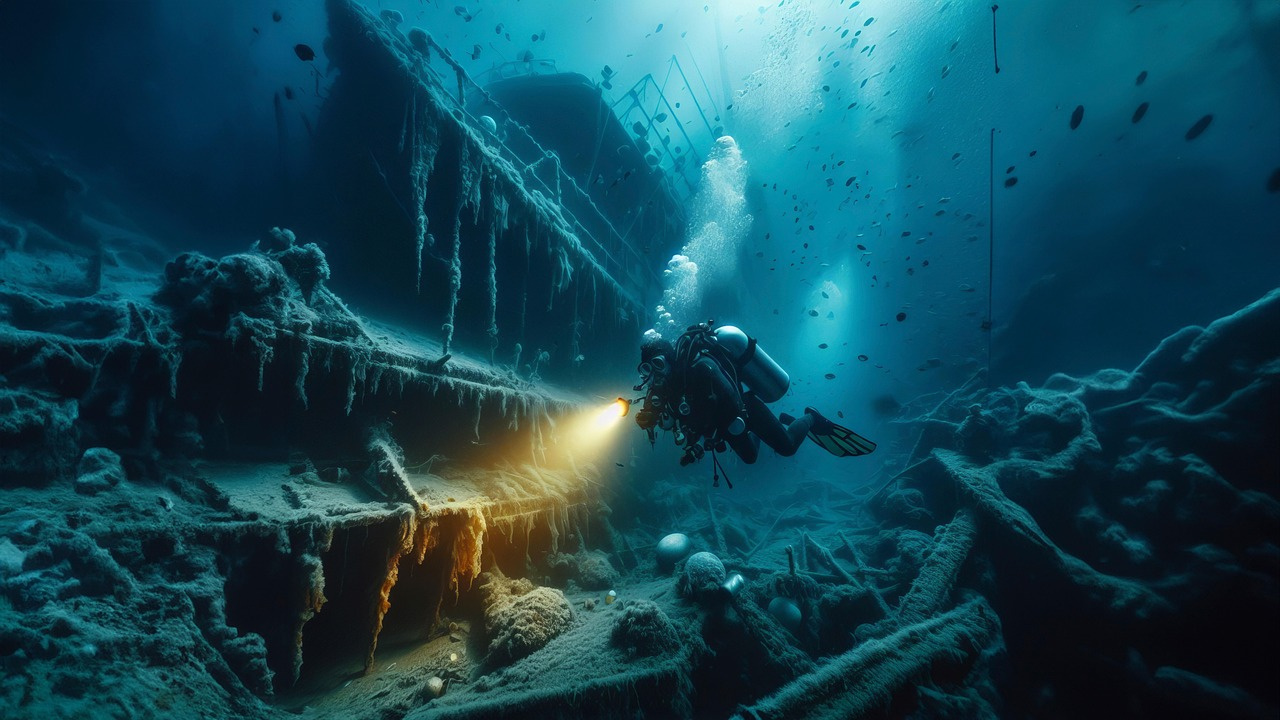
A remarkable maritime mystery has been solved on the remote Scottish island of Sanday in the Orkney archipelago, where researchers have successfully identified a 250-year-old shipwreck discovered by a local schoolboy in February 2024. The vessel, which emerged from beneath coastal sands after a severe winter storm, has been confirmed as the Earl of Chatham, formerly known as HMS Hind, a Royal Navy frigate that served during some of the most significant military conflicts of the 18th century before being converted into a whaling ship.
The identification represents a triumph of community-driven archaeology, combining advanced scientific analysis with meticulous historical research. Through dendrochronology studies, archival investigation, and collaborative efforts between Wessex Archaeology, Historic Environment Scotland, and local community researchers, experts have traced the ship’s extraordinary journey from British naval service through the American Revolutionary War to its final days as an Arctic whaling vessel. The discovery sheds new light on maritime history and demonstrates the power of community engagement in archaeological research.
The Discovery: A Schoolboy’s Run Reveals Hidden History
The story began in February 2024 when a young schoolboy jogging along Sanday’s windswept beaches noticed unusual wooden structures protruding from the sand dunes. The winter storms that had battered the Orkney Islands had swept away centuries of protective sand cover, exposing the oak ribs of an ancient wooden vessel. For the tight-knit community of approximately 500 residents on this 20-square-mile island, the find immediately sparked intense curiosity and mobilized local resources.
Sanday has long been known as Scotland’s cradle of shipwrecks, with roughly 270 recorded wrecks along its treacherous coastline since the 15th century. The island’s position in the North Atlantic, combined with unpredictable weather patterns and dangerous underwater terrain, has made it a graveyard for ships throughout maritime history. However, this particular discovery would prove exceptional in both its historical significance and the community response it generated.
Local farmers responded immediately to secure the fragile timbers before they could be damaged by tides or further storms. Using tractors and trailers, community members carefully excavated and transported approximately 12 tons of oak timbers from the beach to safety. The collaborative effort demonstrated the island’s deep connection to its maritime heritage and set the stage for what would become an exemplary model of community archaeology.

Community Mobilization and Initial Preservation
Sylvia Thorne, one of the community researchers who participated in the recovery effort, described the experience as both exhilarating and meaningful for the island. The collaborative spirit that emerged around the discovery reflected Sanday’s historical relationship with shipwrecked mariners. Historical records show that while the island gained notoriety for its dangerous waters, its inhabitants were equally renowned for their hospitality toward sailors who survived wrecks along its shores.
The recovered timbers were immediately placed in temporary storage while arrangements were made for proper conservation. Community members recognized that wood preserved underwater for centuries would rapidly deteriorate if exposed to air, requiring specialized preservation techniques to prevent irreversible damage. This quick thinking and coordinated action proved crucial in safeguarding the historical materials for scientific study.
Scientific Analysis Reveals the Ship’s Origins
Following the recovery, researchers from Dendrochronicle conducted comprehensive dendrochronological analysis on the timber samples. Dendrochronology, the scientific method of dating wood through tree-ring patterns, provided the first critical clues to the vessel’s identity. By examining the growth rings in the oak timbers, scientists determined that the trees used in the ship’s construction were felled in southern England during the mid-18th century, specifically around 1749.
This dating precision proved fortunate for researchers, as Ben Saunders, senior marine archaeologist at Wessex Archaeology, explained. The mid-18th century coincided with a period when British naval bureaucracy was becoming increasingly systematic and detailed in its record-keeping. This meant that comprehensive documentation existed for ships built during this era, providing researchers with rich archival resources to consult during their identification efforts.
The dendrochronological findings established that the ship was constructed using timber sourced from the south and southwest regions of England. This geographical origin, combined with the construction date, significantly narrowed the list of potential candidates. Researchers could eliminate vessels built in Northern Europe, ships constructed with timber from other British regions, and craft built outside the identified time window.
Archival Research and Historical Investigation
With the scientific dating complete, Wessex Archaeology archaeologists, local community researchers, and the Sanday Heritage Centre embarked on months of intensive archival research. Their investigation took them through historical shipping records, naval documents at the National Archives and National Maritime Museum in London, contemporary newspaper accounts, and local community records preserved on Sanday itself.
The research team compiled a comprehensive list of known shipwrecks in the waters around Sanday during the relevant time period. Through a systematic process of elimination, they excluded vessels based on multiple criteria including size, timber origin, construction techniques, and documented service history. As investigators removed candidates that didn’t match the physical evidence, the list of possibilities dwindled dramatically.
Eventually, researchers focused on a small number of viable candidates, with one vessel standing out as the most likely match: the Earl of Chatham. Further investigation revealed that this whaling ship had an even more remarkable history than initially suspected, as it had previously served the Royal Navy under a different name during some of the most pivotal military campaigns of the 18th century.

HMS Hind: A Naval Vessel’s Distinguished Service Record
The archival research uncovered that the Earl of Chatham began its life in 1749 as HMS Hind, a sixth-rate 24-gun frigate built in Chichester on England’s south coast. As a frigate, the Hind represented a class of warship valued for its speed, maneuverability, and versatility rather than overwhelming firepower. These characteristics made frigates ideal for convoy escort duties, counter-privateer operations, and supporting larger fleet actions.
Under the command of Captain Robert Bond, HMS Hind saw its first major action during the Seven Years’ War, also known as the French and Indian War in North America. In early 1758, the frigate joined a substantial fleet assembled at Portsmouth under Admiral Edward Boscawen for an ambitious expedition against the French stronghold of Louisbourg in Nova Scotia. The fleet departed Portsmouth on February 19, 1758, arriving at Halifax on May 9 after crossing the North Atlantic.
From Halifax, the naval force proceeded to Louisbourg, arriving on June 1, 1758. Throughout the subsequent siege, which lasted until the fortress’s surrender on July 26, HMS Hind actively supported British Army operations. Following the successful capture of Louisbourg, the frigate participated in transporting 500 soldiers to Port-la-Joye on nearby Île Saint-Jean in late August, where French forces also surrendered.
Quebec Campaign and American Revolutionary War Service
HMS Hind’s naval service continued with participation in the 1759 Quebec campaign. In February 1759, the frigate sailed from Spithead as part of Vice-Admiral Charles Saunders’ fleet destined for the expedition against Quebec. The voyage proved long and challenging, with the fleet reaching Louisbourg in April only to find the harbor blocked with ice, forcing a diversion to Halifax. The expedition finally departed for Quebec in May and June, with Saunders’ fleet joining Commodore Philip Durell’s squadron at Île-aux-Coudres on June 23.
Years later, HMS Hind returned to active service during the American Revolutionary War in the late 1770s and early 1780s. The vessel served as a convoy escort, protecting British merchant vessels and military supply ships traveling to and from the American colonies. Between 1780 and 1781, the frigate’s crew demonstrated considerable effectiveness in this role, successfully intercepting at least four American privateers that threatened British maritime commerce.
Following the American Revolutionary War’s conclusion, HMS Hind underwent conversion to a 10-gun armed transport at Sheerness from September 1782 through January 1783. The vessel served briefly in this reduced capacity before being paid off in November 1783. On January 8, 1784, the Royal Navy sold HMS Hind, marking the end of its 35-year naval career but the beginning of an entirely new chapter in the ship’s existence.
Transformation Into a Whaling Vessel
London shipowner and merchant Theophilus Pritzler purchased the decommissioned HMS Hind and converted it into a whaling vessel, renaming it the Earl of Chatham. This transformation from warship to commercial whaler was a common practice in late 18th-century Britain, as the transition made economic and practical sense for multiple reasons. Royal Navy vessels were solidly constructed to withstand combat damage and rough seas, making them well-suited for the demanding conditions of Arctic whaling.
The relationship between war and whaling in Britain during this period was symbiotic. During times of conflict, the Royal Navy recruited experienced mariners from the whaling industry to crew its warships. Conversely, when conflicts ended and naval personnel sought civilian employment, the whaling industry experienced growth spurts as skilled sailors returned to commercial maritime work. Decommissioned naval vessels provided the physical infrastructure for this expanding industry.
The Earl of Chatham joined approximately 120 London-based whaling ships operating in the Greenland Sea during this era. These vessels hunted bowhead whales in the Arctic waters off Greenland, processing their catch for whale oil, which had become an essential commodity during the Industrial Revolution. Whale oil served multiple critical purposes including lubricating factory machinery, softening textiles, and illuminating city streets throughout Britain and Europe.
Successful Whaling Seasons and Arctic Operations
Under Captain William Brown’s command, the 500-ton Earl of Chatham completed four successful whaling seasons in Arctic waters. Historical records indicate that over these four seasons, the vessel returned to British ports with more than 350 tons of whale blubber, representing a profitable commercial operation. The ship’s naval construction, originally designed to withstand combat conditions, proved equally valuable for enduring the harsh Arctic environment and the physical demands of whaling operations.
The whaling expeditions required vessels capable of navigating through ice-filled waters, withstanding severe storms, and providing stable platforms for processing whale carcasses. HMS Hind’s robust construction as a Royal Navy frigate meant the vessel possessed these necessary characteristics, demonstrating how military engineering inadvertently created ideal platforms for commercial Arctic operations.
The Final Voyage and Shipwreck
On April 29, 1788, during what should have been preparations for the Earl of Chatham’s fifth whaling season, disaster struck. While heading out to the Arctic whaling grounds, the vessel encountered severe weather near Sanday. The combination of unpredictable wind patterns, treacherous underwater geography, and stormy seas that had claimed so many ships in Sanday’s waters proved fatal for the Earl of Chatham as well.
The ship wrecked in the Bay of Lopness off Sanday’s coast, breaking apart in the violent seas. However, in what researchers have described as one final stroke of the vessel’s remarkable luck, all 56 crew members aboard survived the wreck. Contemporary newspaper accounts, including reports in the Aberdeen Journal from 1788, documented the incident and praised the Sanday community’s rapid response in rescuing the sailors and providing them with shelter and assistance.
The successful rescue of all crew members reinforced Sanday’s reputation for hospitality toward shipwrecked mariners. Despite the island’s dangerous waters and its nickname as Scotland’s cradle of shipwrecks, its inhabitants maintained a strong tradition of supporting sailors in distress. This historical pattern of community assistance would be echoed more than two centuries later when Sanday residents again mobilized to preserve the Earl of Chatham’s remains.
Modern Preservation and Display
Following the 2024 recovery, the ship’s timbers were transferred to a specially prepared freshwater tank at the Sanday Heritage Centre. This conservation measure was funded by the National Heritage Memorial Fund and provides a stable environment essential for preserving waterlogged wood. Without continuous submersion, the centuries-old timbers would rapidly dry out and crumble, destroying invaluable historical material.
The freshwater tank housing approximately 12 tons of oak timbers allows visitors to view the preserved remains while learning about the Earl of Chatham’s extraordinary history and Sanday’s maritime heritage. The Heritage Centre has developed interpretive materials explaining the ship’s dual identity as both HMS Hind and the Earl of Chatham, its service in major 18th-century military campaigns, and its later role in Arctic whaling.
Alison Turnbull, Director of External Relations and Partnerships at Historic Environment Scotland, emphasized the discovery’s significance and the exemplary nature of the community-led investigation. The project demonstrated how local communities possess unique knowledge and resources for understanding their own heritage, with professional archaeologists and scientists serving as partners rather than external authorities imposing interpretations.
Future Plans and Ongoing Research
Discussions are underway regarding permanent display options for the Earl of Chatham’s remains. Community stakeholders, heritage professionals, and local government representatives are collaborating to determine how best to present this significant find in ways that honor Sanday’s unique character and maritime history while making the discovery accessible to visitors and researchers.
The project has inspired increased interest in Sanday’s broader maritime heritage. Community researchers have expressed enthusiasm about continuing historical investigations into other documented shipwrecks around the island and developing educational programs that connect younger generations with their maritime past. The success of this identification project has demonstrated that combining scientific expertise with community knowledge and engagement produces outcomes superior to either approach alone.
Climate Change and Future Maritime Archaeology
The Earl of Chatham’s exposure after more than two centuries hidden beneath protective sand raises important questions about climate change impacts on coastal archaeology. Researchers note that the wreck was revealed due to changes in weather patterns, including increased storm intensity and altered wind patterns affecting Britain’s coastlines. These environmental shifts are predicted to accelerate in coming decades, potentially exposing numerous additional historical shipwrecks currently protected by sediment.
Ben Saunders emphasized that while such discoveries offer exciting opportunities for archaeological research and historical understanding, they also present conservation challenges. Wrecks that have been preserved in stable underwater environments for centuries become vulnerable once exposed to air, wave action, and changing environmental conditions. The rapid community response that protected the Earl of Chatham’s timbers may not be possible for every newly exposed wreck, particularly in remote locations.
This reality underscores the importance of developing proactive strategies for monitoring vulnerable coastal areas, training local communities in heritage preservation, and establishing rapid-response protocols for newly discovered archaeological materials. The Sanday experience provides a valuable model, but not all communities possess the same combination of resources, expertise, and organizational capacity that made this project successful.
Significance for Maritime History
The identification of HMS Hind adds valuable information to historians’ understanding of 18th-century naval operations, the transition from military to commercial maritime activities, and the British whaling industry’s role in the Industrial Revolution. The vessel’s participation in pivotal military campaigns including the sieges of Louisbourg and Quebec, along with its service during the American Revolutionary War, connects it to major historical events that shaped North American and European history.
The ship’s conversion from naval frigate to whaling vessel also illustrates broader economic and social patterns of the era. The symbiotic relationship between naval service and commercial whaling, the industrial demand for whale products, and the adaptation of military technology for civilian purposes all reflect important aspects of late 18th-century British maritime culture and economy.
Furthermore, the Earl of Chatham’s story provides a human dimension to historical narratives. The 56 crew members who survived the 1788 wreck, the Sanday residents who rescued them, the naval officers and sailors who served aboard HMS Hind during its military career, and the whalers who worked the Arctic seas all contributed to the vessel’s rich history. Their experiences, now partially recovered through archaeological research, offer insights into maritime life during a transformative period in global history.
A Model for Community Archaeology
Perhaps the most significant legacy of the Earl of Chatham project lies not in the ship’s identification itself but in demonstrating effective models for community-engaged archaeology. Traditional archaeological practice often positioned local communities as passive subjects or sources of labor rather than active partners in research and interpretation. The Sanday project inverted this relationship, with community members serving as co-researchers, decision-makers, and knowledge holders.
This approach recognizes that communities possess invaluable expertise about their own environments, histories, and heritage resources. Local knowledge about geographic features, family histories, oral traditions, and historical patterns can provide insights that external researchers might never access independently. Combining this community expertise with professional archaeological and scientific methods creates more comprehensive and nuanced understanding than either approach alone.
The project also demonstrates how heritage research can strengthen community identity and engagement. Sanday residents have expressed pride in the discovery and their role in identifying and preserving the wreck. The process has sparked increased interest in local history, encouraged intergenerational knowledge sharing, and created opportunities for community members to develop new skills in archaeological research, conservation, and heritage interpretation.
Implications for Future Heritage Projects
Professional archaeologists and heritage organizations are studying the Sanday project as a potential model for similar initiatives elsewhere. The successful collaboration between Wessex Archaeology, Historic Environment Scotland, local community researchers, and the Sanday Heritage Centre demonstrated that well-structured partnerships can achieve excellent results while respecting community autonomy and expertise.
Key factors contributing to the project’s success included early and meaningful community involvement, transparent communication, shared decision-making authority, adequate funding for community participation, and recognition of local expertise. These elements created an environment where professional and community researchers worked as genuine partners rather than in hierarchical relationships.
Conclusion
The identification of the 250-year-old Sanday shipwreck as HMS Hind, later renamed the Earl of Chatham, represents a remarkable achievement in maritime archaeology and community-engaged heritage research. From its initial discovery by a schoolboy in February 2024 through the collaborative scientific analysis and historical investigation that revealed its identity, the project demonstrates the power of combining advanced archaeological techniques with community knowledge and dedication.
The vessel’s extraordinary history encompasses service in major 18th-century military campaigns including the Seven Years’ War and American Revolutionary War, followed by successful commercial operations as an Arctic whaling ship. This dual identity as both naval warship and commercial whaler reflects broader patterns in British maritime history and the Industrial Revolution’s economic demands. The ship’s ultimate fate off Sanday’s treacherous coast, combined with the miraculous survival of all 56 crew members, adds human drama to the historical narrative.
Beyond the specific historical details, the Earl of Chatham project offers valuable lessons about effective heritage management and the importance of community participation in archaeological research. The rapid mobilization of Sanday residents to recover and protect the timbers, their sustained engagement throughout the identification process, and the ongoing collaboration regarding preservation and interpretation demonstrate what can be achieved when communities are treated as genuine partners rather than passive stakeholders.
As climate change continues altering coastal environments and potentially exposing additional shipwrecks currently protected by sediment, the Sanday model provides a framework for responding to such discoveries. The combination of immediate community action, professional scientific expertise, comprehensive historical research, and thoughtful long-term planning for preservation and interpretation created an exemplary outcome that honors both the vessel’s historical significance and the community’s connection to its maritime heritage.
The preserved timbers now resting in their freshwater tank at the Sanday Heritage Centre serve multiple purposes: they provide physical connection to dramatic historical events, demonstrate the effectiveness of community archaeology, and remind visitors of the treacherous seas that have claimed so many vessels along Sanday’s shores. Most importantly, they represent a community’s determination to understand, preserve, and share its unique heritage with future generations, ensuring that HMS Hind’s remarkable story continues to inspire and educate long after the ship itself met its fate in Orkney waters.








